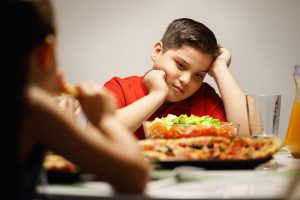How To Make Family Dinner, Family Connection Time
Do you rush to get a healthy dinner on the table and find your hopes for a nice meal dashed immediately? Arguments between kids, trouble staying at the table, inadvertent spills can transform a lovely opportunity for connection into a battle zone. Instead of positivity, you can’t wait until everybody’s eaten and you can sit for a minute alone.  Family dinners are not only an important way to come together as a family but also a time to teach social skills. Eating together, no matter how briefly, offers a chance to pay attention to each other. You practice listening, making eye contact and the ritual of sharing food. The trick is how to do this with less conflict and more enjoyment. Dinner time needs to be a tech-free time. Instead of checking with your phones, check in with each other. Try the ritual of asking for a high and low from the day. This gives each person a chance to share something that went well and something that didn’t. To keep the focus positive, you can follow up on the high note with a related question. Or ask a specific question about a class, lunch or recess related to who they sat next to or played with. Try to avoid general questions such as “How was your day?” or discussing potentially upsetting topics such as homework. You can discuss these after the meal.
Family dinners are not only an important way to come together as a family but also a time to teach social skills. Eating together, no matter how briefly, offers a chance to pay attention to each other. You practice listening, making eye contact and the ritual of sharing food. The trick is how to do this with less conflict and more enjoyment. Dinner time needs to be a tech-free time. Instead of checking with your phones, check in with each other. Try the ritual of asking for a high and low from the day. This gives each person a chance to share something that went well and something that didn’t. To keep the focus positive, you can follow up on the high note with a related question. Or ask a specific question about a class, lunch or recess related to who they sat next to or played with. Try to avoid general questions such as “How was your day?” or discussing potentially upsetting topics such as homework. You can discuss these after the meal.  Many kids with ADHD have trouble sitting at the dinner table or even focusing on eating their food. If this is the case in your house, I’d recommend against turning on the television or iPad to distract them so they’ll eat and try these activities instead:listen to an engaging audio book, play a card game and offer small meals. Sometimes kids prefer grazing: eating a little bit, taking a break and coming back to the table. Work with your son or daughter to create a plan that makes sense to them and satisfies your goals of being sure they consume nutritious food. Bon Appetit!
Many kids with ADHD have trouble sitting at the dinner table or even focusing on eating their food. If this is the case in your house, I’d recommend against turning on the television or iPad to distract them so they’ll eat and try these activities instead:listen to an engaging audio book, play a card game and offer small meals. Sometimes kids prefer grazing: eating a little bit, taking a break and coming back to the table. Work with your son or daughter to create a plan that makes sense to them and satisfies your goals of being sure they consume nutritious food. Bon Appetit! 
